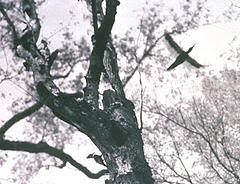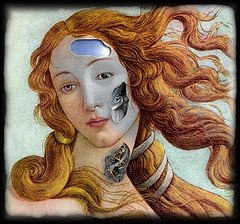Warmer
The extracts come from Dan Brown's Da Vinci Code and Alex Garder's The Beach respectively. Technically speaking they are of the same quality, but the writing style is of very different standard.
Brown's description is relatively complicated in terms of sentence structure and vocabulary. It is heavy, lacks flow and even sounds as though the author is trying too hard. Consequently, his description fails. It's failure can be attributed to the fact that the reader becomes aware of the writer and disbelief is not suspended.
On the other hand Garder is 'invisible'. He uses simple sentence structure that is unburdened by excessive descriptive vocabulary. It is easy to imagine the girl and her impact on those present in the cafe. Consequently, we are quickly drawn into the scene.
These two extracts are examples of how art can possess or completely lack 'spirit'. In the readings that follow the notion of spirit in art, and even people is investigated. The text comes from Immanuel Kant's Critique of Judgement published in 1790.
Teachers should not the identity of the author at this stage. It is important for students to try to understand, without being intimidated by the idea, that they are reading what could be considered difficult philosophy.
Questions
Paragraph 1
1) What is the writer's objective in this essay?
He is going to investigate the idea of 'spirit'. It appears to be that certain indefinable something that makes an artwork, a piece of writing or speech or even a woman beautiful.
2) What do you think 'spirit' is?
This is an important question and the central theme of this blog. Most of us have an idea what 'spirit' is even though it is very difficult to put into words. The French expression d'avoir une petite quelquechose, ('to have a little somehthing') sums up the idea that we know what it is but cannot describe it. Suffice it to say that 'spirit' is that thing that makes something or someone moving, wonderful, inspiring, exciting, fascinating, and so on.
Paragraph 2
1) What is the function of the phrase 'the material it employs for this'?
2) Spirit employs a substance to affect the mind. Describe what it does to the mind?
Paragraph 3
1) What is the function of the phrase 'which prompts much thought'?
2) Why can't aesthetic ideas be properly expressed in words?
Paragraph 4
1) How does imagination bring freedom?
2) Who do you think is the author of this essay?
- The author is Immanuel Kant. The text comes from his work Critique of Judgement published in 1790
The Secular Sacred, Authenticity etc.
Somerville(2009 p.54), in her search for a universal ethics, defines the secular sacred as something 'authentic with a life of its own. This is reminiscent of Kant's spirit which 'prompts much thought', a kind of progentior of ideas and something that is almost self sufficient. In turn this is a reminder of Juliet's love for Romeo in that the more it is given the more it is produced:
The more I give to thee, The more I have, for both are infinite. Act II.Scene 2
There is a circular relationship here, that Somerville compares to a snake swallowing its tail. Spirit engenders more spirt. authenticity engenders more authenticity. As Somerville (2009 p.55) puts it:
"We need to experience awe and wonder to access a sense of the sacred; but, in turn, that sense can be the doorway to awe and wonder."
The pursuit of authenticity is key for SCI, language acquisition of Krashen, and central to the NAL teaching concept. That is, having the mysterious ingredient of authenticity, spirit, a life of its own or the secular sacred is likely to enhance language acquisition. This is because it stimulates thought and in turn the speech necessary to attempt to describe it.







+II+-+socialist+art+by+night+_eulen.jpg)








